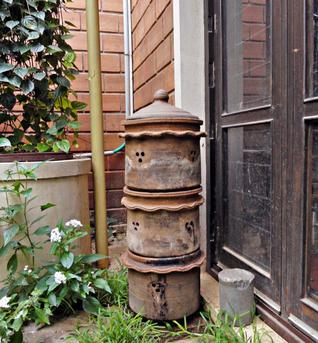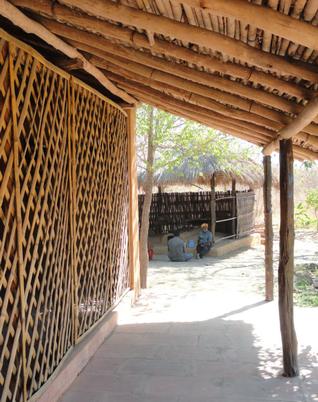Monthly Archives: September 2013
Home composting is easy
 How do natural materials produced around us get disposed? The simple answer could be ‘by composting’. Incidentally, archaeologists have studied places occupied by human habitation millions of years ago by studying the decomposed waste matter left behind and discovered new knowledge about how people might have lived then!
How do natural materials produced around us get disposed? The simple answer could be ‘by composting’. Incidentally, archaeologists have studied places occupied by human habitation millions of years ago by studying the decomposed waste matter left behind and discovered new knowledge about how people might have lived then!
Composting as a process refers to, in simple language, letting the material rot and reduce to powdery form, reduce its water content and effect shrinking of the volume of the material, all achieved through microbial breaking of the cellular structure by bacterial action. Nature anyway does it, but we can do it our way and benefit from it.
For those who have access to ground, the simplest system is to dig out a 2’x2’x2’ pit, keep dumping the garbage into it, cover with thin film of dried leaves or soil and keep repeating it everyday. Larger pits can also be used. It should be thoroughly mixed periodically and ensure no water flows into it. Some harmless fruit flies may fly over it, but ignore them or pour another layer of soil. Once this pit is full, dig another next to it. By the time the second pit gets full, the fist one may be ready with manure for use.
In Bangalore, an initiative called Daily Dump advices using Khamba system, a versatile idea applicable everywhere. It uses three earthen pots placed one over the other where we fill garbage in turn. Daily dump of waste is to be covered with dry layer of saw dust or paper or dry leaves or dry mud, with or with composting culture media. The culture media like coconut pith manure and mixes produced in laboratories ensure the bio garbage gets composted fast and properly. Anyway, as one pot gets filled up, it is kept down while the next pot is being filled such that periodic mixing produces the manure as the pots take turn to receive the garbage.
The composting process produces a blackish liquid called leech and slightly smelling carbon gas which can be reduced by periodic and proper turning the mix over. Mixing provides it with aeration and supply of oxygen. There could also be some heat within the compost pit, which does not affect us.
What matters is to get soft, powdery, granular humus mix as the end product that is a great example of recycling the waste. While plants anyway grow in any soil condition, the compost mix as an external addition creates a condition with moisture retention, air penetration, plant nutrients, effective drainage of rain water and reduced soil erosion. As such, the plant grows with healthy roots.
Composting can save the city
 All living beings on the land come from soil and finally return to soil, a simple rule of nature that has ensured a balanced ecological cycle for millions of years. While the right kind of composition of all constituent ingredients of an object brings it forth to life, the decomposition of these ingredients leads to decay and death of the material. Composting is a biological term for this act of decomposing, which happens everyday for all bio-degradable materials such as vegetables, fruits, cooked food, cotton, timber, leafy matters with cellulose, meat and other animal products. As human beings if we can ensure this process, we are contributing to the cycle of nature. If not, we are the villains breaking this cycle.
All living beings on the land come from soil and finally return to soil, a simple rule of nature that has ensured a balanced ecological cycle for millions of years. While the right kind of composition of all constituent ingredients of an object brings it forth to life, the decomposition of these ingredients leads to decay and death of the material. Composting is a biological term for this act of decomposing, which happens everyday for all bio-degradable materials such as vegetables, fruits, cooked food, cotton, timber, leafy matters with cellulose, meat and other animal products. As human beings if we can ensure this process, we are contributing to the cycle of nature. If not, we are the villains breaking this cycle.
If we walk into rural settings, natural materials rotting and decaying around is a common sight. We may scoff at it, but in reality it is a healthier activity than having non-biodegradable wastes like plastics and other manufactured materials floating around. In villages, the bio-waste gets decomposed in the open with smell and flies; hence we tend to think of composting itself as a disease causing activity, which is not all true. Incidentally, it is possible to let this decay happen in a regulated way, without emanating any smell or fear of ill health and collecting rich garden manure as the end product.
Reduce the burden
Urban dwellers tend to hang their hands in air, when we discuss about solid waste disposal saying it needs to be solved by the collective system, where an individual family can do nothing. Besides generating less waste, we can recycle all degradable materials into compost, reduce the burden on the city in disposing of the waste and turn this waste into a value-added product. In an urban set-up, 1 to 2 kg of solid biodegradable waste is generated everyday by an average family that can be a heavy burden on the city administration, but it can be easily composted even at a small apartment itself and definitely in a plotted house.
Organic matters, primarily leftover items during cooking in our own homes, should be kept separate and put into the composting bin or pit if we have land. It is such a simple daily activity that after a few weeks becomes a routine. Occasionally turn the waste around, add culture media to speed up the composting activity if so desired, wait for the required weeks — the compost is ready. With more than half the volume of bio-wastes being water, the dampness reduces, volume shrinks, and compresses the waste as days pass by. Everyday one kg waste may sound high, but it requires less than 4 sq. ft. of floor area for composting it.
Home composting gives us the joy of being with nature and an activity with a feel-good factor that we can talk about. It only requires further study, understanding of the concept and appropriate application.
Bamboo needs our support
 Where does India stand in world rankings in bamboo cultivation? It’s an answer we can be proud of – we are second, next only to China. The extensive tropical region in our country enables this production and is climatically suited for its usage also. As such increased production, easy availability and regular supply can be assured for bamboo, except in few regions.
Where does India stand in world rankings in bamboo cultivation? It’s an answer we can be proud of – we are second, next only to China. The extensive tropical region in our country enables this production and is climatically suited for its usage also. As such increased production, easy availability and regular supply can be assured for bamboo, except in few regions.
Where does bamboo last longer, thanks to local climate? Again India – extreme temperature and humidity variation reduce the life of bamboo, but in most areas of India with moderate temperature variation, bamboo can last long. All this to confirm that India is ideally suited for bamboo buildings.
Bamboo needs three to five years to grow to maturity, by when it can be cut for construction though the basic height could be achieved in six to nine months. Even without any treatment, it can perform well beyond six years, but with minimum maintenance, many village bamboo structures have lasted beyond 20 years. Of course the best is to artificially treat it, to reduce termite attack, dry and wet rot, surface water penetration and such others, thereby ensuring durability and extended life.
Treatment
The most common bamboo treatment is dipping the culms in a solution of 2 kg boric acid and 3 kg borax dissolved in 45 litres of water for two to three days, tank especially made narrow and long to fit the bamboo poles. Copper Chrome Boron solution with pressure impregnation method is also possible, where necessary facilities are available.
Among the recurring questions on bamboo building is costing. It is difficult to arrive at a standard cost, but budgetary range for the proposed construction can be suggested by subject experts. However, this should not be directly compared with conventional methods to arrive at the lowest quotation and work awarded to a contractor.
The public sector uses standard schedule of rates for tendering projects, wherein bamboo will not find an easy place. It is good news that there are now increased attempts to develop a widely acceptable Indian standard code on bamboo, which will help promoting its use.
There are many individuals and organisations passionately working towards a better future for this material such as Wonder Grass, IGBMT, IPIRITI, Laurie Baker Building Center, INBAR, and Bamboo House India. Despite their dedicated efforts, the larger part of India’s production goes for paper making.
A notable quantity is used for non-construction items such as crafts, basketry, daily use items, and woven forms like screens and mats.
While such a wide use is laudable, it will be good to see an equally wider use in construction industry, for a greener and sustainable future.
The challenge in using bamboo has been our mindset than the material itself, though in certain areas it may not be feasible for varied reasons. If we can introspect why we are not using bamboo, we may realise our misconceptions and relook at this wonder grass.
- Bamboo needs three to five years to grow to maturity, by when it can be cut for construction, though the basic height could be achieved in six to nine months.
- Treat bamboo artificially to reduce termite attack, dry and wet rot, surface water penetration and such others, thereby ensuring durability and extended life.
- Even without any treatment, it can perform well beyond six years, but with minimum maintenance, many village bamboo structures have lasted beyond 20 years.
From foundation to roof
 Between bamboo and structural steel, which one has more strength? Which one will perform better in case of deep soil pile foundation? If left open without any protective coat, which one will last longer without rusting or withering? Which one has more options of application and is versatile enough for wall, column, beam and floors?
Between bamboo and structural steel, which one has more strength? Which one will perform better in case of deep soil pile foundation? If left open without any protective coat, which one will last longer without rusting or withering? Which one has more options of application and is versatile enough for wall, column, beam and floors?
The surprise answer for all the above is bamboo. At an average tensile strength of 12,500 kg/sq. in., it is 2,000 kg units more than that of steel. The stems of bamboo, popularly called poles and technically as culms, have been traditionally used for pile foundation in water-logged and loose top soil sites. Bamboo mats can be laid as foundation bed in case of soils with low load-bearing capacity. As a versatile material, it is good for both temporary and medium term usages, besides for long term, if designed and built properly.
While bamboo can be used as a single pole, it works equally well in groups and as a composite material. For transferring heavy loads, multiple numbers of culms, say 3 or 4, can be joined by nuts and bolts to act like a single column. Likewise, it is possible to form beam trusses in groups or in lattice formation. Of course, all the bamboo poles in such composite forms need to belong to the same species, of similar girth and be of comparable maturity of age.
In Kerala, lime concrete bamboo reinforced beams have been attempted since the late 1990s and in regular use since then at the Laurie Baker Centre. While stand alone use is feasible, bamboo gains more potential as part of a composite structure and reinforcement material.
Traditional walls
The traditional bamboo walls were made with woven bamboo mat with mortar coats on both sides, so that bamboo is not exposed to any adverse weather condition. While lime and mud mortar goes better with the natural material, cement mortar can also be used. Subsequently, protective painting coats can be applied. Being 2 to 3 inch thick, they are light weight, hence save on structures. If split bamboo culms are used, keep them to the outside with inside finished as desired. External silica-based skin of bamboo resists fire for a while, but can be improved by chemical coatings. Bamboo boards with split lengths and panel are very popular as visual barrier in semi-open spaces like verandahs and pavilions.
Roof supports by bamboo rafters are very commonly found even today. Thicker girth culms are used as ridge beams or wall beams, while the smaller diameter ones can go for principal rafters in sloping and cross beams in flat roofs. Their spacing may vary from 1 to 2 metres depending upon context. Floor finish can be achieved by 1:6 ratio lime mud or cement mortar with topping by floor tiles and any other item of choice. There are many valid reasons to use bamboo, which need to be explored further.